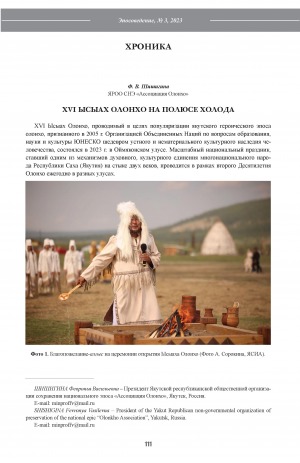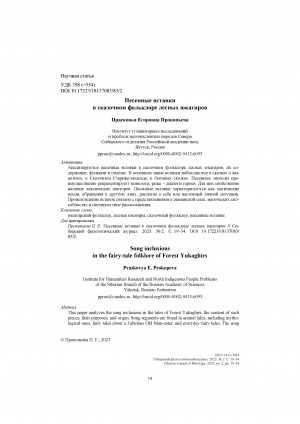Количество страниц: 4 с.
- 1. Андреева Тамара Егоровна. Прилагательные, обозначающие черты характера человека в эвенкийском языке = Adjectives denoting character traits in the Evenk language
- 2. Мухоплева Светлана Дмитриевна, Оросина Надежда Анатольевна. Второй Республиканский научно-практический форум "Олонхо и олонхосуты: проблемы бытования и ревитализации в XXI веке"
- 3. Насилов Дмитрий Михайлович. Проблемы обучения родным языкам коренных малочисленных народов Севера в диалектных условиях = Problems of teaching native languages of indigenous peoples of the North in dialect conditions
- 4. Васильева Римма Иннокентьевна. Основные показатели современной этноязыковой ситуации в Республике Саха (Якутия) (по материалам Всероссийской переписи 2010 года) = Key indicators of the modern ethno-linguistic situation in the Republic of Sakha (Yakutia)(based on the all-Russian census of 2010)
- 5. Васильева Надежда Матвеевна, Данилова Надежда Ивановна, Нелунов Анатолий Гаврильевич, Попова Наталья Иннокентьевна. Якутская орфография в новой редакции = The Yakut spelling in the new edition
- 6. Готовцева Лина Митрофановна. Взгляд на природу фразеологических единиц якутского языка = View of the nature of the phraseological units of the Yakut language
- 7. Харрис Робин. Ключевые факторы обеспечения устойчивого будущего эпических традиций = Key factors in providing sustainable futures for epic traditions
- 8. Ларионова Анна Семеновна. Особенности традиции эпического пения якутов Горного улуса (на примере олонхо Н. М. Тарасова) "Быстроногий Неспотыкающийся Нюсер Беге") = Features of the Yakut epic singing tradition of Gorny region(for example, Olonkho N.M. Tarasov "Swift-Footed, Sure-Footed Nuser Bege"): [статья посвящена изучению особенностей эпического пения олонхосута из Горного улуса Н. М. Тарасова]
- 9. Саввинов Анатолий Иванович. Фольклор ессейских якутов: к истории собирания, изучения и публикации = The folklore of the Essene Yakuts: the history of collecting, studying and publishing
- 10. Филиппова Виктория Викторовна. ГИС-технологии в исследовании истории Якутии (по материалам Приполярной переписи 1926-1927 гг. и Всесоюзной переписи 1939 г.) = Geographic information system in the research of history of Yakutia (based on Circumpolar census 1926-1927 and All-Union census 1939)
- 11. Жукова Людмила Николаевна. Археологические разведки Якутского республиканского краеведческого музея им. Ем. Ярославского в конце XX века = Archaeological exploration of the Yakut Republican Local History Museum named after Em. Yaroslavskogo at the end of the XX century
- 12. Васильев Валерий Егорович. Шаманизм народа саха: к вопросу о сущности и систематизации традиционных верований = Shamanism of the Sakha people: essence and systematization of traditional beliefs
- 13. Чарина Ольга Иосифовна. Формы бытования эпических произведений русских старожилов Якутии = Forms of the existing of the epic works of the Russian old residents of Yakutia
- 14. Павлова Надежда Васильевна. Сказочный репертуар Д. А. Томской = Fairy repertoire of D. A. Tomskaya
- 15. Северо-Восточный гуманитарный вестник, 2016, №1 (14)
- 16. Северо-Восточный гуманитарный вестник, 2016, №2 (15)
- 17. Северо-Восточный гуманитарный вестник, 2016, №3 (16)
- 18. Северо-Восточный гуманитарный вестник, 2016, №4 (17)
Данилова, А. Н.
Николай Васильевич Емельянов (к 95-летию со дня рождения) / А. Н. Данилова, Н. А. Оросина ; Институт гуманитарных исследований и проблем малочисленных народов Севера // Северо-Восточный гуманитарный вестник. - 2016. - 1 (14). - С. 115-118.
Количество страниц: 15 с.
Dobzhanskaya, O/ E. The Living Has Sound. The Dead Is Silent / Oksana E. Dobzhanskaya ; Moscow State University // Anthropology & archeology of Eurasia. - 2016, Т. 55, N 1. - С. 7-21. - DOI: http://dx.doi.org/10.1080/10611959.2016.1263485
DOI: http://dx.doi.org/10.1080/10611959.2016.1263485
Ответственность: Садоков Р. Л. (Секретарь)
Издательство: Наука
Год выпуска: 1970
Серия, номер выпуска: Т. 7
Количество страниц: 576 с.
- Общественные науки. Образование > Этнография. Обычаи. Жизнь народа. Нравы,
- Математика. Естественные науки > Общая биология. Антропология. Вирусология. Микробиология,
- НАУКА ЯКУТИИ > ОБЩЕСТВЕННЫЕ НАУКИ > Этнография. Обычаи. Жизнь народа. Нравы,
- НАУКА ЯКУТИИ > МАТЕМАТИКА. ЕСТЕСТВЕННЫЕ НАУКИ > Общая биология. Антропология. Вирусология. Микробиология.
VII Международный конгресс антропологических и этнографических наук, Москва (3-10 августа 1964 г.) = VIIme Congres internationaldes sciences anthropologiqueset ethnologuques, Moscou (3 Aout — 10 Aout 1964) / под редакцией: С. П. Толстова (председатель редакционной коллегии), Ю. П. Аверкиевой, С. И. Брука [и др.]. - Москва : Наука, 1970..
Т. 7. - 1970. - 567 с. : ил., карт., нот.
Издательство: ИФП СО РАН
Год выпуска: 2015
Серия, номер выпуска: Вып. 10
Количество страниц: 231 с.
- 1. Этносоциальные процессы в Сибири: тематический сборник
Вып. 1, Вып. 1, 1997 - 2. Этносоциальные процессы в Сибири: тематический сборник
Вып. 2, Вып. 2, 1998 - 3. Этносоциальные процессы в Сибири: тематический сборник
Вып. 3, Вып. 3, 2000 - 4. Этносоциальные процессы в Сибири: тематический сборник
Вып. 4, Вып. 4, 2001 - 5. Этносоциальные процессы в Сибири: тематический сборник
Вып. 5, Вып. 5, 2003 - 6. Этносоциальные процессы в Сибири: тематический сборник
Вып. 6, Вып. 6, 2004 - 7. Этносоциальные процессы в Сибири : тематический сборник
Вып. 7, Вып. 7, 2006 - 8. Этносоциальные процессы в Сибири : тематический сборник
Вып. 8, Вып. 8, 2006 - 9. Этносоциальные процессы во внутренней Евразии: [тематический сборник]
Вып. 9, Вып. 9, 2008
Этносоциальные процессы в Сибири : тематический сборник. Ethno-social processes in Siberia : subject anthology / Российская академия наук, Сибирское отедление, Институт философии и права ; ответственный редактор Ю. В. Попков ; редакционная коллегия: В. А. Бойко, В. С Золототрубов, В. Г. Костюк [и др.]. - Новосибирск : ИФП СО РАН, 1997- . - 20 см. Вып. 10. - 2015. - 230 с.
Издательство: Институт философии и права СО РАН, Семипалатинский государственный университет им. Шакарима
Год выпуска: 2008
Серия, номер выпуска: Вып. 9
Количество страниц: 769 с.
- 1. Этносоциальные процессы в Сибири: тематический сборник
Вып. 1, Вып. 1, 1997 - 2. Этносоциальные процессы в Сибири: тематический сборник
Вып. 2, Вып. 2, 1998 - 3. Этносоциальные процессы в Сибири: тематический сборник
Вып. 3, Вып. 3, 2000 - 4. Этносоциальные процессы в Сибири: тематический сборник
Вып. 4, Вып. 4, 2001 - 5. Этносоциальные процессы в Сибири: тематический сборник
Вып. 5, Вып. 5, 2003 - 6. Этносоциальные процессы в Сибири: тематический сборник
Вып. 6, Вып. 6, 2004 - 7. Этносоциальные процессы в Сибири : тематический сборник
Вып. 7, Вып. 7, 2006 - 8. Этносоциальные процессы в Сибири : тематический сборник
Вып. 8, Вып. 8, 2006 - 9. Этносоциальные процессы в Сибири: тематический сборник
Вып. 10, Вып. 10, 2015
Этносоциальные процессы во внутренней Евразии : [тематический сборник] / Российская академия наук, Сибирское отделение, Институт философии и права, Министерство образования и науки республики Казахстан, Семипалатинский государственный университет им. Шакарима, Семипалатинский русский социально-культурный центр. - Семей : Институт философии и права СО РАН : Семипалатинский государственный университет им. Шакарима, 2008- . - 30 см. Вып. 9. - 2008. - 767 с.
Количество страниц: 4 с.
Шишигина, Ф. В. XVI ысыах олонхо на Полюсе Холода / Ф. В. Шишигина ; Ассоциация Олонхо // Вестник Северо-Восточного федерального университета им. М. К.Аммосова. Серия "Эпосоведение". - 2023. - N 3 (31). - С. 111-114.
DOI: 10.25587/2782-4861-2023-3-99-107
Количество страниц: 16 с.
This paper analyzes the song inclusions in the tales of Forest Yukaghirs, the content of such pieces, their purposes, and origin. Song segments are found in animal tales, including mythological ones, fairy tales about a Fabulous Old Man-eater, and everyday fairy tales. The song inclusions mostly convey the monological speech of the characters and include lexical repetitions. The song inclusions considered are mainly the magical appeal of one hero to another, a personal story, or a real personal situation. Some of them can be characterized as personal songs. Characters endowed with supernatural powers use the song as a magical ritual. These characters include heroes with shamanic powers and the ogre giant, the Fabulous Old Man. The magical potential of the song, aimed at summoning and embodying something, can also be evoked by ordinary people, even unintentionally. Songs-appeals of some characters to others are performed in magical situations, facilitating their manifestation. The fairy tales provide indirect indications of the shamanic power of the singing characters. Alternatively, the songs addressed to other persons can be performed by ordinary characters, usually represented by animals. Songs as personal narratives or real personal situations can be found mainly in the tales about animals. The song inclusions are based on the representations of shamanic activity, magical abilities, and the song type of storytelling, as evidenced by the existence of both non-fairy and fairy tale Yukaghir prose.
Прокопьева, П. Е. Песенные вставки в сказочном фольклоре лесных юкагиров / Е. П. Прасковья ; Институт гуманитарных исследований и проблем малочисленных народов Севера // Сибирский филологический журнал. - 2023. - N 2. - С. 19-34. - DOI: 10.17223/18137083/83/2
DOI: 10.17223/18137083/83/2
Издательство: Наука. Санкт-Петербургское отделение
Год выпуска: 1992
Количество страниц: 116 с.
Ойунская, Сардана Платоновна.
Якутские народные загадки : специфика жанра / С. П. Соловьева - Ойунская ; ответственный редактор Н. В. Емельянов ; Российская академия наук, Сибирское отделение, Якутский научный центр, Институт языка, литературы и истории. - Санкт-Петербург : Наука. Санкт-Петербургское отделение, 1992. - 110, [1] с.
Количество страниц: 12 с.
The article presents the result of the procedure for resolving the issue of forming dictionary vocables, as well as organizing a dictionary entry in the dictionary of the language of the Yakut heroic epic Olonkho, proclaimed by UNESCO in 2005 as a masterpiece of the oral and intangible cultural heritage of humanity. The question was one of the rather complex problems in the theoretical development of a dictionary of the Olonkho language. The high degree of formulaicity of the language of the Yakut epic, the originality of the stylistics of the epic narrative and the characteristic features of the language of the Turkic peoples generated a complex of original properties of the Olonkho language, which determined the problematic character of lexicographic works. However, when developing the macro- and microstructure of dictionaries of the language of folklore, an unconventional solution to the problem is allowed, and therefore the work proposes a special structure of a dictionary entry, as well as methods for forming non-standard forms of dictionary vocables. To achieve the goal, we analyzed the functional and semantic features of the lexeme aghys ʻeightʼ in the olonkho text Nurgun Bootur the Swift by K. G. Orosin (1947). As a result of the analysis, the following points were clarified and determined: 1. it was decided to present stable verbal complexes of the Olonkho language (i. e. epic formulas, formulaic constructions, constructions of a formulaic nature), phraseological units, single lexemes and epic periods as vocabulary vocables. The main factors that served as support for making such a decision were the distinctive feature of the Turkic languages - the law of synharmonism, as well as the diffuse nature of the meaning of folk expressions, which requires an integrated approach to the compilation of dictionary definitions, including in the design of the lemma part of the dictionary. The basic principles of the structure of dictionary entries in the Olonkho language dictionary are indicated: the order of presentation of units of lexicographic description, the order of presentation of stable verbal complexes, principles of presentation of material, features of presentation of illustrative material. In developing the described principles, we relied on individual aspects of the theoretical positions expressed in the works of our predecessors, specializing in the field of Russian lingua-folkloristics, Russian folklore lexicography, in Turkic studies, as well as the result of a comprehensive analysis of materials from the K. G. Orosin’s olonkho text of Nurgun Bootur the Swift . In the course of further lexicographical work, it will obviously be possible to make minor adjustments, since the language material of the Yakut epic is extremely diverse. However, the result obtained in this article, in this aspect, will definitely form the basis of lexicography.
Роббек, Л. В. О формировании вокабул и организации словарной статьи в словаре языка олонхо / Л. В. Роббек ; Институт гуманитарных исследований и проблем малочисленных народов Севера // Вестник Северо-Восточного федеральногоуниверситета им. М. К. Аммосова. Серия: Эпосоведение. - 2024. - N 1 (33). - С. 45-56. - DOI: 10.25587/2782-4861-2024-1-45-56
DOI: 10.25587/2782-4861-2024-1-45-56
Количество страниц: 10 с.
The investigation of Russian folklore has not yet been fully institutionalized in literature, cinema, and theater. In Russian literature, for example, there are no novels about Koshchei the Immortal, Ivan the Prince, heroes of Slavic pagan culture and many other characters of this genre. Meanwhile, these are deep, colorful images organically integrated into an equally vivid context. Many great writers, such as Thomas Mann, have written about such gaps. The goal is to identify the main typological characteristics of the Russian epic, which, in our opinion, has been studied in this sense very one-sidedly. The methodology is a comparative analysis of various approaches (mythological, historical, structural, etc.) closely interconnected with the characteristic features and structure of epics. At the same time, considerable attention is the harmonious combination of various motifs of the epic: heroes, Kalik-passers-by, epic time, pagan influences, hyperbolization, etc. An attempt is made not to accept, but to take into account various influences on such studies (pre-revolutionary, post-revolutionary, inspired by the Marxist approach, structural analysis, which began to be used in the study of Russian epic since the 1970s). The Russian epic, thanks to a huge number of historical, social, and cultural connections, naturally interacts with the epics of the republics (union and autonomous) that were part of the former USSR, which opens up wide opportunities for comparative studies of various types. Paths are outlined for a comparative analysis of the Russian epic with the epics of the East Slavic peoples, as well as with the Yakut heroic epic Olonkho. The authors' further plans involve continuing the study of Russian folklore in the genre of fairy tales and the field of culture of Slavic paganism. The first of them has been studied quite fully, but the structural and systemic approaches to research need to be further developed. The culture of Slavic paganism is a little-studied area where there are still no established approaches, and there are different points of view on many issues. Here you can apply the methodological approaches outlined in our monograph “Philosophy of Olonkho”.
Кожевников, Н. Н. Основания и компаративистский анализ русского эпоса / Кожевников Н. Н., Данилова В. С. ; Северо-Восточный федеральный университетим. М. К. Аммосова // Вестник Северо-Восточного федерального университета им. М. К. Аммосова. Серия "Эпосоведение". - 2024. - N 2 (34). - С. 67-76. - DOI: 10.25587/2782-4861-2024-2-67-76
DOI: 10.25587/2782-4861-2024-2-67-76









